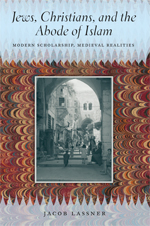|
Reviewed by Prof. David Meier, Department of Social Sciences, Dickinson State University Extending back over five decades, Jacob Lassner lectured on Jewish Civilization at Northwestern University and on the history of the Middle East at Tel Aviv University. During those years, Lassner authored numerous acclaimed studies in the history of the Medieval Near East. In this recent publication, Lassner sustained a thread found in many of his works, namely, exploring Jewish, Christian, and Islamic perceptions of the other within the Dâr al-Islâm. Rooted in a common monotheistic tradition, their cultural and historical traditions evolved together (and in reaction to life) within Islamic society. With a consistently readable format, Lassner introduces readers to the major trends in modern scholarship guiding our contemporary understanding of Islam and Islamic society. In 2003, Lassner edited S. D. Goitein’s five-volume A Mediterranean Society (2000) use of the Cairo Geniza into a single volume. The Cairo Geniza, according to Lassner, offer a “detailed picture of interfaith relationships.” (x) In the opening chapters, Lassner outlines the trends within scholarship that have defined attitudes towards the other where understanding eludes easy connections. Philological considerations, in turn, unveil additional serious differences of meaning when defining key concepts by all sides. Western terminology employed by Arab scholars for a Western audience often fail to convey the nuances of the similar terminology within Islamic social discourse. In his final chapter, Lassner couples Christians, Jews and Muslims in a “cross-pollination” of philosophical discourse and scientific inquiry. Assessing trends in modern scholarship, Lassner’s tour de force revisited the premises of prominent Orientalists, including those in Edward Said’s Orientalism (1978). Characterized by “intellectual panache” and “erratic scholarship,” Said leaned for his polemic on more popular works dating back to the opening of the 20th century. Consistent within Arab scholarship in the 1960s, Said identified the mistakes of Western Orientalists as mirroring the influence of “Western culture and political hegemony.” Said ridiculed Orientalists for misunderstanding even the basic precepts of Islam. Said’s polemic enjoyed a popular reception but failed to either integrate extensive German scholarship or the more critical studies of Arab society by prominent Arab scholars. (92-93) Paralleling Said’s polemic, Occidentalists, including the western educated Mohammad Talbi and A. L. Tibawi, appeared progressive yet mired in anchored assumptions about the divine origins of the Qur’an while polemical aspirations seemed to drive them away from more nuanced contemporary scholarship in the West. Within this context, western Biblical criticism reinforced Islamic beliefs in the inherent corruption of the West and its scripture. Mohammad Talbi’s western-sounding terminology, however, concealed essential differences regarding toleration, freedom and respect for pluralism as understood in the West. (88 & 114-118) As in early Islamic polemical writings, Christians and Jews appear to recognize and then reject Mohammad as a prophet. In short, Lassner exposed parallels between contemporary attitudes legitimized through alleged historical evidence. Polemical (or popular) literature existed in all three camps. As opposed to more scholarly aspirations, polemical literature is inclined to mock, insult, and humiliate. Within the Dâr al-Islâm, Christian-Jewish polemical literature flourished, providing material for Islamic polemical and scholarly misrepresentations of Jews and Christians – a point deserving more attention. Lassner’s concluding chapter addresses lost opportunities on all sides. Medieval Islam proved a haven of intellectual exchange whereas modern Islam took little note of the changes unfolding in the Christian West. Where Arabic medieval translations of Greek philosophers alongside Arabic commentators acted as a catalyst to Europe’s own intellectual reawakening, these ties faded in the emerging modernity for more provocative even proto-nationalistic identities. Overall, Lassner identifies the sources of contemporary discord as less a product of the Medieval Islamic world and more as a consequence of contemporary misrepresentations (or virtual demonization) of the other. As Lassner approaches the alleged Gordian knot, it seems revisiting Medieval Islamic history combined with shedding misunderstandings generated by more modern scholars could dispel tension on all sides. On the other hand, Arab nationalism, Pan-Arabism and Islamicism movements represent intellectual constructs without clear precedent while abstinently holding to more medieval perceptions of the West. Lassner downplays Jewish-Christian medieval polemics as a factor where Daniel J. Lasker’s Jewish Philosophical Polemics Against Christianity in the Middle Ages (1977; 2nd ed., 2007) exposed the vitriolic side of Jewish polemical writings against Christianity in Islamic Spain. Nevertheless, Lassner offers readers a solid introduction into the contemporary scholarly discourse about the Middle East both today and in medieval times. |


 Jews, Christians, and the Abode of Islam: Modern Scholarship, Medieval Realities
Jews, Christians, and the Abode of Islam: Modern Scholarship, Medieval Realities